TRANSCRIPTION OF DR. WIBLE’S PRESENTATION
PART ONE (video):
INTRODUCTION: Dr. Pamela Wible is a family physician born into a family of physicians. Her parents warned her not to pursue medicine, but she followed her heart only to discover: To heal her patients she had to first heal her profession. So she held town hall meetings & invited her community to design their own “ideal clinic.” Open since 2005, Dr. Wible’s community clinic has sparked a movement in which citizens are designing ideal clinics nationwide. Her model is taught in medical schools and featured in Harvard School of Public Healthʼs Renegotiating Health Care: Resolving Conflict to Build Collaboration, a textbook examining major trends with the potential to change American heath care.
Dr. Wible is the co-author of two award-winning anthologies and the author of Pet Goats & Pap Smears: 101 Medical Adventures to Open Your Heart & Mind. She has been interviewed by CNN, ABC, CBS, and is a frequent guest on NPR. Today, she will share how you can create your own ideal medical clinic.
DR. WIBLE: A zen poet said, “A person who is a master in the art of living makes little distinction between their work and their play, their labor and their leisure, their mind and their body, their education and their recreation, their love and their religion. They hardly know which is which and simply pursue their vision of excellence and grace, whatever they do, leaving others to decide whether they are working or playing. To them they are always doing both.
So that’s how I practice medicine. It’s like a love fest party everyday. Just imagine having so much fun at work that you don’t even feel like you are at work. That is possible in health care. So just a few things I’ll bring up:
1) I haven’t set an alarm for work in over 9 years because I am self-employed and I work afternoons and evenings. I’m not really a morning person. So it’s great! I never really had that option when I worked for somebody else.
2) I give balloons to patients and I practice womb-to-tomb medicine. So it’s fantastic. Everyone gets balloons now no matter where they are in the life cycle.
3) I only work a few half days per week. Because I don’t really believe in working so hard that I’m exhausted. And I think that we should be models of health for our patients. To have a balanced life is actually more than just lip service. When recommending lifestyle and diet changes to your patients, it’s way better if you are actually modeling it rather than just saying it.
So what happened is I started realizing how much fun I was having at work and how little fun it my colleagues looked like they were having at work. In fact, they looked pretty miserable. So I started writing this book, Pet Goats & Pap Smears, primarily because I had medical students wanting to shadow with me and after working with me they would say, “Wow! You’re the first happy doctor we’ve ever met!” And then they would say, “We were told in medical school that being in solo practice isn’t possible anymore.” And so they were just kinda shocked—on many levels—to find out what they are taught is not true. You actually CAN have a thriving solo practice. And make MORE money than you would make working for somebody else (because you are not giving all the parasites a cut in the middle). And you can have more fun because really you are more likely to be a self-actualized person who reaches the top of Maslow’s Hierarchy of Needs if you work for yourself. Let’s just face it. Unless you happen to find an employer that is totally on the same page as you which I wasn’t able to do in 6 jobs over 10 years. I never found anyone who had the same vision as me because we are all here with a unique purpose and most of us who are called to heal have felt that spiritual calling from maybe grade school onward. We are offering ourselves in a very unique way to our patients so to expect that you would find an employer that would have the same exact healing mission as you have—it’s like one in a million. And then in a capitalistic society where, ya know, hoarding money is considered the way to win in life, you are not really necessarily going to find somebody who aligns with you. If you are focusing on life from a place of meaning and spirituality, it’s really hard to find that in a capitalistic medical system.
So anyway, I wrote this book and it has my best 101 patient stories from 20 years of being a doctor, mostly in an ideal medical practice. It’s like “chicken soup for the doctor’s soul—without sacrificing the chicken.” (laughter) I went to all these book marketing events and they wanted us to locate in the bookstore where our books should be sold. But there’s no location for happy, uplifting medical books in the bookstore. In Barnes & Noble there are a very few books in health care that are really uplifting and inspiring. It might be the first in its own genre of “happy Pap smear books with goats.” (laughter) which this is actually a real picture in my office. This is not photoshopped. Like the goat is actually there. (laughter) And she’s a medical student on the front cover who attends a Chinese medical school in Chicago. So she is one of you!
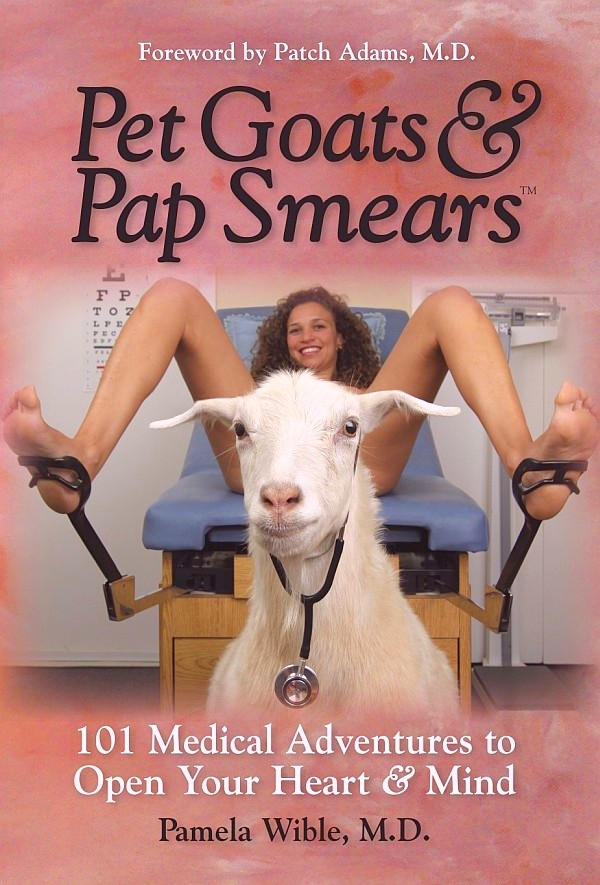
I wrote this book and I was super-excited to get it out to everyone. I felt like a little proselytizer. Wow, look! We could be having fun! Isn’t this great? And I was really excited to finally have something to give people and then 2 days later—after I published this on September 29, 2012—one of the pediatricians in our town shot himself in the head in the middle of the day in a public park. And so I guess I finally understood it’s really hard to inspire people who are so far gone. You know what I mean? I’m in a profession of allopathic doctors who are basically PTSD’d out. I don’t know if you’ve been to an allopathic doctor lately, but, like, is anyone home? Their eyes are glazed over. They look like they’re suffering more than their patients. It’s really sad because I love my profession. Both my parents are doctors and I see the potential of what medicine can be and it’s heartbreaking for me to see my colleagues in so much distress.
I carry around with me the man who I never met. Here’s the pediatrician in my town who took his own life and left, like, 4 children, and all his pediatric patients who adored him. He was voted one of the the top doctors in Eugene. These are well-respected, well-loved people. Why are they killing themselves? At his memorial service, I realized, “Oh, wow, both the men I dated in medical school are dead.” That was a shock and I thought maybe they were suicides too. Actually they turned out to be drug overdoses. Which was really hard to get confirmation that that’s what it was because nobody likes to talk about it because you can burn in hell forever if you are a religion that believes that or there is stigma about discussing mental health in any real way. So anyway, I carry their pictures around with me. I dated these people. I loved these people. And they are not here. And it’s tragic that this is the state of allopathic medicine right now. We lose 400 physicians per year to suicide. The average doctor has a patient panel of 2500 so nearly 1,000,000 Americans are going to lose their doctor to suicide this year. Anyway, this isn’t supposed to be a depressing talk. I’m just trying to share this is what I was up against when I was like, “Hey! We should be having fun!” Like it didn’t register. Okay.
It’s good that I am talking to you now before you start into your practice because I do think many people, especially in allopathic medicine, do sustain more trauma when they go into their practices. They keep thinking the light will be at the end of the tunnel after my first year of medical school it will get better, after the second year of medical school it will get better, when I start residency it will finally get better, and it never gets better for lots of people and they start their first job where they think they can finally be a doctor and it doesn’t get better because they are working for, let’s just face it, abusive employers. It’s like being in an abusive marriage that you can’t get out of. By that time they are in survival mode and it’s really had to convince them that there’s another way. Because there are not home, ya know. So they need intense therapy.
So it’s great for you all because you are still in school and you can take this in before you make any mistakes and go down a path that would be hurtful to your soul. And I think your program is just less brutal than allopathic training programs, I hope. You are getting enough sleep, and getting yoga, and free massage. Right? Don’t you have to do massage? Wouldn’t it be great if we had to get massage as part of our training in allopathic medical school?
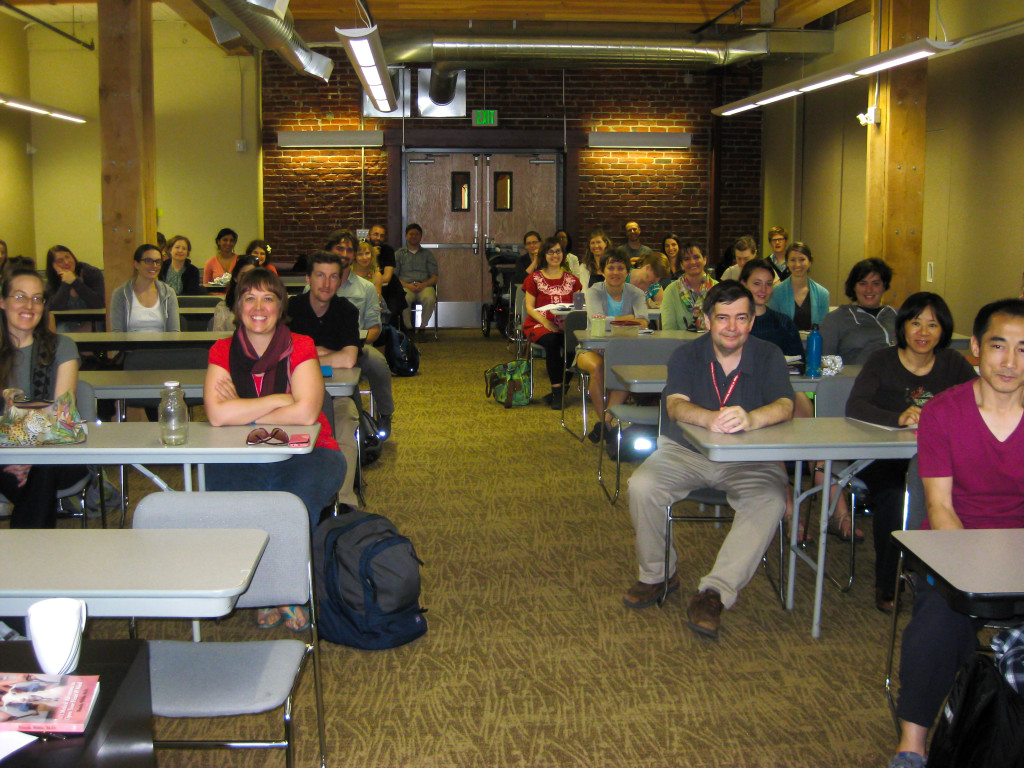
Anyway, so I thought I’d share a few store from the book just so you could understand what a typical day is like for me in my practice. Has anyone read this book? Like 4 or 5 people. Okay. Great. It will be available at the end if anyone wants one. I think I’ll sell them for 10 dollars or something. I sign every book. I kiss every book. (laughter). Yes, I stay up at night and kiss them with my own lips. This is my relationship right now—this book. (laughter)
And so, anyway, there’s a chapter called Forget the ER, Try the DMV. So what happen is that I was just at the YMCA in the dressing room. It was my day off. People think when you are self-employed you will be miserable and you will never be able to get away from your patients because you are the only one and they are gonna call you all the time and they are gonna get on your nerves and it’s gonna be like having 2500 really nagging children hanging around your feet, ya know (laughter). If you are in a functional practice you teach your patients to be really functional and they don’t bother you on your time off for the most part. You have longer enough appointments so that you answer all their questions so you don’t get stray phone calls at all hours of the night. Anyway, this gentleman injured his finger and he called me wanting an appointment. And I was naked in the YMCA dressing room trying to figure out how I was going to see him for an appointment. And then I realized from there I was going to the DMV to renew my driver’s license. And I knew that he lived near the west side DMV in Eugene so I thought (you know, just quick thinking because you know your patients) I thought well instead of him driving all the way to south Eugene (it’s really not that far, Portland is much bigger) so instead of driving the extra 5 minutes to south Eugene, he could just meet me at the DMV, (laughter) and I’ll examine his finger there because I knew he didn’t need stitches based on the way he was talking about it on the phone. It was more like would he need antibiotics for an infection. So when I told him to meet me at the DMV he was super-excited because it turns out he needed to transfer a car title (laughter) so WOW! We took the same number and sat next to each other. I examined his finger. He didn’t need antibiotics and everything was happily ever after and he didn’t have insurance so he paid me 50 bucks. And my license renew was 40. So I made 10 dollars sitting in the DMV! (laughter) and then when they called our number we both went up to the front and he was super-excited and everyone at the DMV is usually not s0 excited and even the people who work there are like, “huh . . .” but everyone was laughing and smiling because she explained how he just had his medical appointment in the waiting room. It was like the coolest thing ever. Think out of the box. It’s sometimes easier to have your medical appointments in a park or in a swimming pool or somewhere else besides your actual office since it can be more convenient and more healing. So that’s one fun story from the book. I’ve done a lot of other appointments at grocery stores, in the YMCA, and other places . . .
Then there’s a chapter called Soap Opera. Most of the chapters, by the way, are 1 to 3 pages and they all have cartoons. Perfect bathroom reading. The soap opera story is about a gift basket beside my door in my office because in case I run late I like to be able to give people a gift. Ya know, instead of just saying, “I’m sorry I’m late, I’m sorry I’m late, I’m sorry I’m late,” which was like my standard line for 10 years working in other clinics, I never thought, “Oh! Wow! Let me give them a door prize,” or do something more than say, “I’m sorry I’m late.” You know. So I thought okay this is great. I could go to Saturday Market and basically support local artisans who are making these amazing soaps and lotions and body care products and cool stuff that people could use anyway and so I’m supporting the local economy and I am allowing people to pick a gift that’s worth maybe 5 dollars or less. I have a lot of goats’ milk soap in there. I somehow glommed onto goats lately. If I’m more than 10 minutes late they get a gift. And it’s really cool because sometimes you open the patient’s chart and you realize it’s the patient’s birthday, but you did not come prepared with a present, but they could pick something from the gift basket. Or it’s their anniversary or some other milestone like they quit smoking and you want to give them a gift and now you are all set up. Sometimes if I’m 9 minutes late, I’ll wait an extra minute just because it is so much fun to give gifts. And they get balloons sometimes too on Patient Appreciation Days. Anyway, what was really funny about the Soap Opera story is that I guess some reporter in New York City found out I was doing this and it was like, “Wow! A doctor is giving gifts to patients!” and it totally made the national news. You know, that’s how far gone we are. So giving someone a pretty cheap gift for being late is amazing enough that this reporter was calling me from Manhattan wanting to do a story on it. The day that he called I happened to be late at the end of the day. Like I think I had 2 patients who got soap and they wanted to interview actual patients. So I called up this woman and she is kind of high anxiety and low self-esteem woman who just couldn’t believe that I was asking her if she wanted to be interviewed on national news.
She’s like, “. . .about what?”
I said, “You got a bar of soap today, right?”
“Yes! I love it. It is really expensive. My husband won’t let me have that kind of soap. Oh my God! It smells so good. I’ve been carrying it around all day.”
“Great! Do you want to talk to a reporter from New York?”
“About what?”
“About the soap.”
She’s like, “Oh my God! On national TV!?”
And I’m like, “No really it’s gonna be a print article.”
“Okay. About the soap?” and she just couldn’t believe it.
And she got interviewed on how she got a bar of soap from me and it was like in a major national called The Daily out of Manhattan and then my residence program found out about it and they all passed it around. “This is one of our residents.” They were so proud because I’m passing soap out to my patients.
I will drive home the point that it does not take much to be newsworthy. Just do something original. You know. You don’t really have to do much. That was mild and it made national news. So that was super-funny.
And then there was a day and this was in my traditional assembly-line job and somebody had left a box of kittens abandoned by the door. And so I brought them in and made a fun circus play area in my office and then I took a sign—a white piece of paper where I wrote “FREE KITTENS with physical. Today only!” And they all got homes by 11:00 am. (Laughter) And everyone got their physicals. It was super-cool. So think out of the box. How can you work with the humane society in your office? You know pets are healing and they are wondering how to get homes for these animals and I’m sure you’ve told people, “Have you thought about getting a dog or staring at a goldfish? That might help your blood pressure.” Bring them into your office and send them home with a pet if you feel like they can handle it. That was super-cool.
Then I started having Pap parties in my office because I realized people are nervous for their exams and they’d rather do it in groups. I started having women come in together for their Pap smears and so I’d bring balloons and party hats.

You can accomplish the same amount of work in a party hat. (laughter) And I don’t know why people don’t think of that. You know what I mean? I keep Mardi Gras beads by my Pap supplies and anytime I go anywhere I’m looking for little things that I can put in my office that will make people laugh. And, of course, you have to pick the right person for the right gag gift. That’s the art of medical practice (laughter). I went to a party supply store where they have all those award ribbons—first place, second place—you know for little kids. They had one that said the CLEAN ROOM AWARD and I just put it in my Pap smear drawer because I knew when the right woman came by who would say, “Oh no! something must be wrong.” I could tell her, “Surprise! You got the clean room award!” They think it’s great. I did that 2 weeks ago. If they want to take it home they can, but most of the time I just recycle it.
Here’s an interesting thing since we all talk about integrative medicine. When people say, “Try integrative medicine,” and you are not even integrated yourself. Your life is a mess. You don’t know where you are going. You’re depressed. You don’t have a clear idea of your destiny in your profession. But you’re telling someone else about integrative medicine. Why don’t we be integrated as people ourselves and just be a role model for how to be integrated. And then if you really think your patient needs something like massage, acupuncture, whatever . . .Ya know I tell people over and over again to try massage. They don’t necessarily go out and try a massage. Because they are scared, they don’t want to take their clothes off, they don’t rely understand what’s gonna happen. Then some people don’t have the money. They don’t even know where they would find a massage therapist even in Oregon where every other person is a massage therapist. So I brought a massage therapy student into my office and just paid her $40 per hour (you know, there are lots of students who just want to volunteer for you and do stuff for free) so I just had her massage my patients’ hands and feet during their appointments. That’s integrative medicine. You’re actually doing it at the same time. Not get your Pap smear here and then go google a massage therapist or go down the hallway and knock on Kate’s door and get a massage. That’s not exactly integrated. Thats like doing things one at a time in a row and I don’t even know what they are doing because they might not even listen to me. So bring the people to them. I scheduled all my high-needs psych patients like on OHP all on one day and they all got hand and feet massages which is great because some of them said that was the first time they ever experienced safe touch in their lives. They didn’t really request many drugs that day. It was great for me during the visits because I asked, “So what else is going on?” and they didn’t have a lot to say. They were super-happy and they weren’t clinging to me as much and asking for drugs that I know won’t help them. They finally felt safe in their bodies and it’s cool. You can do that. How can I integrate things together for people? Like do the extra brainwork to bring people together and offer services at the same time instead of thinking that some people can doing handle this on their own.
And Patient Appreciation Days. I totally recommend it. Just on random Fridays and sometimes I do it every day of the week, I have balloons and chocolates and sometimes when they come in they get a balloon and I get all different balloons from the dollar store. Like I know who’s coming in. I know these people. So I know what balloon should say what and who should get it. I know who needs a get well ballon and I know who needs “It’s your special day!” And I know who needs a heart. Sometimes I let them pick. But I like to go out and welcome them with “Its your special day!” And they’re so excited because they are adults who get to leave a medical visit with a balloon. Which we keep thinking children are the ones who should get stickers. But if you look around at people I think adults look way more depressed than children (laughter). Adults are the ones who need Cracker Jack prizes and the free gifts in cereal boxes and balloons and stickers because we’re not having as much fun as we should.
This is going to be really interactive and I’m gonna answer all your questions before I leave in an hour when this is over, but I’m gonna stay as long as it takes to answer everyone’s questions. Sometimes I’ve sat in the hallway answering questions for 2 hours. I try to be fast paced and get a lot of information out. If you want to take notes , go for it. I’m gonna cover everything that was promised in the little flyer.
First I have to say I reviewed your catalogue and you guys get a lot more practice management than any medical student I know. Which is really depressing again for allopaths because you all really understand how to run a business when you graduate and we still are clueless because we don’t get trained in practice management as well as you do. So congratulations! You should be really successful. You are ahead of us.
So what I promised is you should be able to claim your vision and liberate yourself to practice medicine in alignment with your values and the values of your community, how to engage your community, and how to thrill patients and staff, and it is super-easy to do that. All you have to do is lead a town hall meeting, which doesn’t have to be as scary as it sounds. Like some people are not really public speakers and they don’t want to do a town hall meeting. But ya know what? I just got to say if you go out and lead a town hall meeting, you will probably have more people show up to hear you than John McCain had during his Presidential town halls where they had to bus people in from nursing homes to fake fill the room, and sometimes it was super-embarassing because they rented a stadium and they only file done row of seats. I know we don’t get generally get trained in community organizing in medical school, but if a doctor really went out and said, “I care about my neighborhood and my community and I want to know what you want.” Like you would have so many more people show up for your authentic request than for politicians.
And if you’re not comfortable with a town hall meeting, you could have a community visioning circle with your friends, or at neighborhood center. You need to figure out who you want to serve. If you want to do pediatrics, maybe you want to visit schools. Just call a teacher up, maybe a fourth-grade teacher like I’ve done and say, “I want to see how your fourth graders would design an ideal clinic.” And spend an afternoon with them. It only takes an hour really. Pass out pens and papers. And say, “Hey what would a clinic look like if you could design it?” You get all these great ideas for free without paying a $400 per hour consultant which is what doctors do because they are like, “I don’t know what I’m doing because I didn’t get any practice management in medical school, so let me get ripped off and hire somebody for $400 per hour who will tell me what to do.” And then they basically tell you the same thing that’s not working that’s making all the other doctors depressed. “Hire more staff. Bring in more phone lines.” Well that’s the problem. How many phone lines do you need to be happy? More staff is not gonna make you happy.
I did these town hall meetings and it just really clarified what I needed to be doing. Because before this I was kinda getting depressed because I was working at all these different jobs and I just felt the grass would be greener at the next one, but they were all assembly-line, production-line medical clinics. That was never my concept of what I wanted to be when I grew up—I never wanted to be a factory worker. If I want dot do that, I’d work at Toyota. I wanted to be a doctor so I could have time to heal people, but that’s not really part of what doctors get to do with their job descriptions now. Well, let me just ask patients what they want because it is not working for me and they don’t look very happy.
I held 9 town hall meetings. I call them town hall meetings because it was politically subversive and it was like a town hall meeting even though between 4 and 30 people showed up for each one. Some of them were small in living rooms down the street. Some were in community centers. But I got 100 pages of written testimony which I will pass around and you can read. But it’s super-cool what people want. Because they want exactly what you want to give them. They want “a sanctuary, a safe place, a place of wisdom, a place where we can learn to live harmlessly, listen with empathy, observe without judgement, a place where a revolution starts, a new way of seeing where we rediscover our priorities, a place to learn to live, a place to learn to die.” It’s really beautiful what people would like you to be giving them, that we are somehow most of us not doing. “The doctor is waiting for me wham I arrive.” Instead of making the patient wait. Just be ready. That would shock them. At these Patient Appreciation Days, sometimes these patients pick me out randomly from an insurance list of doctors and they don’t even know who I am and then they come and get a balloon and chocolates and a present and an hourlong appointment and they’re like, “Oh my God! I hit the lottery!” I’m like, “I guess you did.” They randomly picked me out of their PacificSource list of primary care providers. Anyway, “minimum 30 minutes per visit” and “the doctor is happy.” These are just random things that I think are cool that people wrote down. “Healing is not symptom suppression. Work with the body not drug people beyond recognition.” And “no high front counters and benches separating people from people. A lounge of sorts. Sofas not hard chairs.” You want to know how to set up a clinic? Literally go ask fourth graders. They want comfortable chairs, fun colors. balloons. I don’t know why we have to teach adults this. It seems like a no-brainer in retrospect. People just want to be having fun. And that is actually just part of healing. Having fun and leaving your appointment laughing is a really good idea—for the doctor and the patient. “I’d like to be treated as a peer and not a commodity. Overstuffed chairs. Eliminate the medical assistant who weighs, and measures, and takes notes that the doctor doesn’t read anyway.” It common sensical and I will just pass this around and feel free to steal ideas from there or have your own meeting somewhere.
PART TWO (video):
I just want to share what shocked me after opening my clinic after 9 town hall meetings and getting 100 pages of testimony and reading it all, I was open 1 month later. Because what people want is so easy to deliver: they just want me. Like a human interaction which you can pretty much do for free. You don’t need extra equipment. You don’t need a big room. You don’t need big overhead. You don’t need special statues and fountains. You can have that if you want, but basically people just want you. So the first person who is willing to be authentic and have fun and be a doctor wins. Right? That’s what the patients want. So do it. It’s so easy. And some of us with PTSD might need a lot of therapy before we can find ourselves again, but it is totally worth it because that’s how we are gonna have health care in this country. Health care is not gonna be delivered through legislation and waiting for the next set of regulations to come from above. Health care is gonna happen when we find our own souls again since that is what is missing in health care. We have lots of technology. It’s great, but we’ve lost our souls. So we just need to figure out who we are again and then be that person. And you’ve learned an amazing skill set from whatever medical school you have attended. That’s just a skill set you are bringing with you. That is not all of you. That’s like 30% of what you are bringing. You are mostly bringing yourself. Because you are a natural born healer or you wouldn’t have gone through all this education to do what you want to do if you did not naturally feel called to heal people which is something you were born with. So don’t forget who you are.
I tell medical students all the time because they forget who they are. I say, “What did you write on your personal statement?” And they don’t always remember and they try to dig it up for me. And then I say, “Well how much are you paying for tuition?” And they’re paying like $50,ooo per year. And so I’m telling them, “Wow! Like you’re paying $200,000 to learn a skill set that will allow you to be the physician that you described on your personal statement for which you were accepted into medical school. It’s not like it’s a big surprise and you secretly want to be something else. You totally disclosed what you wanted to be. Right? Then you go to medical school and they beat that out of you. You can’t be the kind of doctor you want to be. At least thats what medical students tell me. Their dreams get crushed within the first few months of medical school. What is the purpose of doing that? I don’t know. I remind them “Look, you are paying this much money to learn a skill set so you can be who you want to be so don’t get talked out of it.” Probably you are in a much more supportive environment at your school. I hope. You will be happier if you become the person you always wanted to be. And not somebody else. And not a cookie-cutter doctor practicing assembly-line medicine.
And so the BIG shock to my system was like, wow, I’m making more money this way than I was for the man. And I’ll just describe my actual salary to you in both situations and so you can extrapolate for your situation. I heard only 5% of you ever work as an employee for someone else. You mostly go into self-employed solo practices which is super-smart. That’s great! I hope you can help the allopathic doctors do that because we’re really suffering not having any mentors who are as happy as they could be practicing medicine the way it used to be practiced before 1965. So maybe you can shine a beacon of light on to the rest of us. Save us. Okay?
So I compare these 2 models. Right now I am in a Low Overhead Volume Employment model (which I call LOVE). The other option is the Super High Overhead Volume Employment model (which is SHOVE) (laughter) so you get a choice do you want to love your job and practice relationship-driven medicine or do you want to be shoved down an assembly line practicing production-driven medicine. You have a choice. Do you want to practice relationship-driven medicine or production-driven medicine? And you totally know which one you are on by how you feel when you start your day.
In production-driven medicine you get there are you are looking at how many patients are on your schedule and you are counting numbers and you are looking at your watch. You are on a production line.
In relationship-driven medicine you are like, “Oh! Wow! This is great! I get to see Sue at 9:00 am.” and you feel really happy and you don’t feel rushed and that’s because you are in a relationship-driven love-type practice. I think most healers want to be on this side. Maybe some people are happy in urgent care, in fast-paced medicine and if they’re happy that’s great. There’s no right or wrong way. But I see so many people who are living in victim mode, trapped in a SHOVE model that does not work for them and that’s not the only model.
So basically I was an employee who had partnership potential in 2000 to 2002. I spent 2 years in the SHOVE model before breaking free and doing my own thing. And I worked full time. So the difference is on the LOVE side I was self-employed vs. being a [SHOVE] employee. I am part time vs. full time. In the LOVE model I work 3 half days per week which is totally different than working 4 full days per week—really full days, like exhaustion to your bones full days seeing 28 patients per day and 112 patients per week. Now in the LOVE model I see 8 patients per half day and 25 patients per week. I’m seeing less patients per week than I saw in a day.
And people will be like, “Oh, you’re such a slacker!” Doctors like to make fun of each other because “you didn’t play the number game as well as I did.” Well, you know, I actually was able to cure so many of the patients over here [LOVE model] and help them transform their lives because I actually spent time with them. Spinning and churning people around inefficiently and throwing drugs at them 28 patients per day doesn’t make you the winner. I just have to say that (laughter). Doesn’t make you the winner and it doesn’t make me the slacker. I’m actually spending 30-60 minutes with each patient and solving their last 10 years worth of problems that they never got answered on the assembly line. So this [LOVE model] makes more sense to me. I have a patient panel of 400-500 patients, close to 500 now. And then over here [SHOVE] I had a patient panel of 2000. So I was able to take care of 2000 people really, really poorly or take care of 500 people really, really well. You know, it’s much easier to be a good parent for 2 children than 17. You might not remember their names. You have so many kids that you have to put name tags on them and color code their toothbrushes because there’s too many kids in your house. And that is probably how you feel in the SHOVE model. Over here in the LOVE model you can actually do your job because you are working at a humane pace.
We need to bring humanity back to health care. And the way to do that is to allow doctors to be human and work at a human pace. Even though we have gadgets that can do 16 things at once, like, people don’t really want that. They want you to work at a human pace and to spend time with them and give them honest answers to their questions which only you can do. A cyberspace robot can’t really do spiritual healing and emotional connection. You know we really do need people—real live people in health care.
So basically I had an overhead expense of $1000 per month [LOVE] vs. $30,000 per month over here [SHOVE]. Like my overhead was $370,000 per year! I brought in $500,000 per year revenue and $370,000 went to overhead, which probably explains why I was exhausted and I never had time to have sex with my husband and we got a divorce. You know what I mean? If you are that exhausted it doesn’t work. Over here [LOVE] I have a great boyfriend, we have all the time in the world. Waking up at the beginning on the month and owing $30,000 on a credit card is way different than waking up with $1000 on a credit card. At then end of the year I could bring in $140,000 based on the numbers I shared on my LOVE practice (25 patients per week) and with $10,000 overhead basically I could earn $130,000 per year. That is the potential income you could make working for yourself with really low overhead. In the SHOVE model I was on $110,000 salary with a production bonus that was possible. I was supposed to get a $20,000 production bonus but I had to argue with them for 2 years in order to get it and I like these guys, but they were totally willing to keep my money. You know what I mean?
Do you want to work for people who prey on you? That you have to beg for the money that you actually earned? It is so much easier when you work for yourself. You don’t generally gyp yourself out of the money you earned. That is the shocking financial piece.
So there are 3 calculations that you should really understand when you open any type of practice or become an employee. 1) You really need to know your percent overhead (%OH) because that effects the whole quality of your life. So my %OH over here [SHOVE] was 74% and it was basically about 7% over here [LOVE] my first year. So basically what that means is say I see somebody for $100. I’m getting paid $26 before taxes over here [SHOVE]for a 20 minute visit. And over here [LOVE] I give myself 30 minutes, make $100, and I leave the room with $93. It feels so much different when you leave the room with $93 vs. $26 for the same amount of work. I really recommend this side here [LOVE].
So figure out your overhead. Don’t just be clueless. You know how many doctors I ask, “What’s your overhead?” and they have no idea. Especially if they are working for someone else they have no idea. One of the major employers in my town the overhead is like 85% or more! Even worse than my favorite factory job. Like 90% even. Look at these doctors working 15 hours per day and they look exhausted. This is why they are exhausted. Because they’re slaves, ya know. In paper chains. They don’t understand they could just slip out of them at any moment.
Then you should figure out DNW. The second calculation is Days Needed to Work. You really need to understand how many days you need to work every year to pay your overhead. That gives you a lot of clarity. Basically I had a contract over here [SHOVE] that was for 194 days per year. You multiply your DNW by your %OH. So 194 x 74% meant that I worked 143 days per year for FREE! Like just for fun. Just to pay the mortgage on a building that I don’t even own. Ya know. Just give it all away.
Now I work 150 half days per year times 7% is 11 half days. I could pay my yearly overhead in 11 half days which means I could go do medical mission work and not worry about leaving huge debt and hearing the clock ticking on my overhead while I am gone. I went to help at Katrina and I didn’t keep thinking, “Oh! Wow! I’m in the hole for leaving.” Basically my patients were like, “Oh you’re a hero, yeah! Go!” People keep thinking you can’t abandon your patients because that means you are a bad doctor, but my patients were really happy. They thought I was cool for going to volunteer. So you don’t have to feel like you’re in prison unless you put yourself in prison. But you should kinda know what you’re signing up for. If you’re gonna be employed somewhere, you should ask, “What’s my overhead percent?”
The third calculation is NNT which means Numbers Needed to Treat. How many patients do you need to see every year to pay your overhead? Take your DNW and multiply by the average number of patients you see per day. You get a shocking number of how many patients you need to see per year—4004 to pay your yearly overhead. I had to see 4004 [SHOVE] and now I can do it in 91 patients per year [LOVE]. So do you want to pay your overhead by seeing 4004 patients or 91 patients?
By the way, I answer at least 5 questions per patient when they come in for their visits. They want to know is this mole okay, I sprained my ankle, I got migraines, my sex drive, my marriage is falling apart. They have lots of primary care questions. So if you multiply the 4004 patients by the 5 questions or more they’re asking that means I answered over 20,000 medical questions for FREE! Just for fun. And I absorbed all the liability for that. And I just gave my life force energy away in 20,000 questions.
For me it’s pretty clear. Wouldn’t most people want to join me over here [LOVE]? Okay I’ll take a question about that.
QUESTION: Can you do the math one more time? Why are you multiplying your overhead by the days you work?
DR. WIBLE: Your percent overhead is your overhead divided by your total revenue. So that’s the fraction that would give you a percent. So for me over here [SHOVE] it’s 370,000 over 500,000 and that gives you 74%. I wanted to know how many days I needed to go to work for free to pay my overhead. So I took 74% (my %OH) and multiplied it by 194 days in my yearly contract. That meant I worked 143 full days which is 8.6 months out if the year for FREE! Like a slave. Clueless. I had no idea I was doing that until I managed to extract myself and figure out these calculations. I knew there was a calculation for how fatigued doctors are and this is the calculation that will determine the quality of your marriage, whether you spend time with your children, and even enjoy the wonderful mountains and great skiing . . . all the things they promise you when you sign the contract. If you’re already being taxed 74% on your income BEFORE you pay state and federal tax, you are possibly gonna feel like shit. Sorry to say. It’s just a lot to pay. And then you take that and multiply it by the number of patients you see per day to get NNT. And I think that gives you a lot of clarity about what you’re doing in your practice. And whether you like how you are setting things up. And whether the extra square footage was really worth it. Was it really worth having 3 exams rooms when you could have had a lower NNT, DNW, %OH and more time off?
QUESTION: Did you base your calculations on a salary that would be ideal for you?
DR. WIBLE: No I based it on the real numbers. Being kind of a sleuth at my last employed job, I always wanted to see the numbers and I kept track of all that because I somehow knew it would make for a good book later and I wanted to know about this. I prepared the before and after because I just knew one day I would break free and I wanted to be able to have the real numbers . . .
QUESTION: Overhead is supposed to make life easier for the doctor. When patients call they want to hear someone live answer the phone. Could you give us an example of what things you cut out?
DR. WIBLE: First I want to say anyone in the room or in cyberspace should Facebook friend me and e-mail me for a 14-page FAQ with all this information so you don’t have to take all these notes. It’s the cheat sheet to how to open an ideal clinic. When you look at what people want they want YOU. Nowhere in the testimony do they say they want another receptionist and another phone line. The practice management journals that are suggesting that you do this are out of sync with what patients want. It’s totally different in tertiary care where you need a team and you’re having a lung transplant. And the helipad has to be there. We’re talking primary care, pretty simple stuff. So basically (I don’t do this) you can do online scheduling with AppointmentQuest for something like $6 per month. I have people e-mail me and I have a system set up where it takes 2 e-mails to schedule and since I have low volume and I’m a control freak. I like to make my own schedule. So I schedule online and it does not require any phone calls except from the 3 or so older people who don’t have Internet. So I do them the old fashion way by phone. Most people schedule online and then come to their appointments right on time. So it’s great becauseI’m ready when their appointment starts or I send them to the gift basket full of soap. And they come in and while I’m talking to them I’m doing their blood pressure and their pulse and there is really no reason for anyone else to be there.
In most clinics there’s bullet proof glass and patients have to fight to get in and then knock on the glass and then they open it up and the person on the other side doesn’t really look all that happy to see you, they’re like, “Why are you here?” and I say, “Because I have a cough.” And then I gotta sit for 2 hours coughing all over everyone in the waiting room. And then they finally take you back and you’re still coughing and the nurse comes in and says, “Why are you here?” and you say you have a cough and they write it down and they leave and then the doctor comes in and says, “Why are you here?” They haven’t read that you have a cough and it should be obvious because you are coughing. You know, too many cooks in the kitchen. Who wants that? It doesn’t make any sense. You know what I mean? This is totally too complex for primary care. So if you remove all these people who are basically in your way. Let’s just face it. They were in my way. Like I feel so much happier not having all these people running round. This is like being married to somebody and going to sleep at night and your CPA is in the room with you and you’ve got your insurance agent, and it’s like what are these people doing there?
Honestly health care is a sacred relationship between 2 people who are going to have a physical, emotional, and spiritual healing experience. Okay? Which if you do it right both people feel invigorated. You feeling invigorated as the doctor and the patient leaves smiling and laughing. And it all went really week. The more people you put in between, the less likely that you will have time or even make an adequate income after you try to connect with someone real quick in a 5-minute visit. You know they teach you don’t put your hand on the door knob because that makes the patient feel like you’re leaving. You should see the kind of stuff they teach us. This is the kind of practice management we get. In allopathic medical school they teach us to sit down even if it’s for 30 seconds because it makes the patient feel like you were there longer. You know what I mean? We have to learn this total BS when really why don’t they just leave us alone so we can be the healers we were born to be with the skill set we learned in whatever medical school we attended that fits our personality and our sense of wisdom.
MAN IN AUDIENCE: That was AWESOME!!
DR. WIBLE: Cool!
MAN IN AUDIENCE: That was really great! I am so glad I taped that. I am going to listen to that 100 times!
DR. WIBLE: Awesome! Okay! Yes, put it all over the Internet. That’s great. Everyone should know this. Okay here is some of what I promised on the little flyer that I saw in the bathrooms:
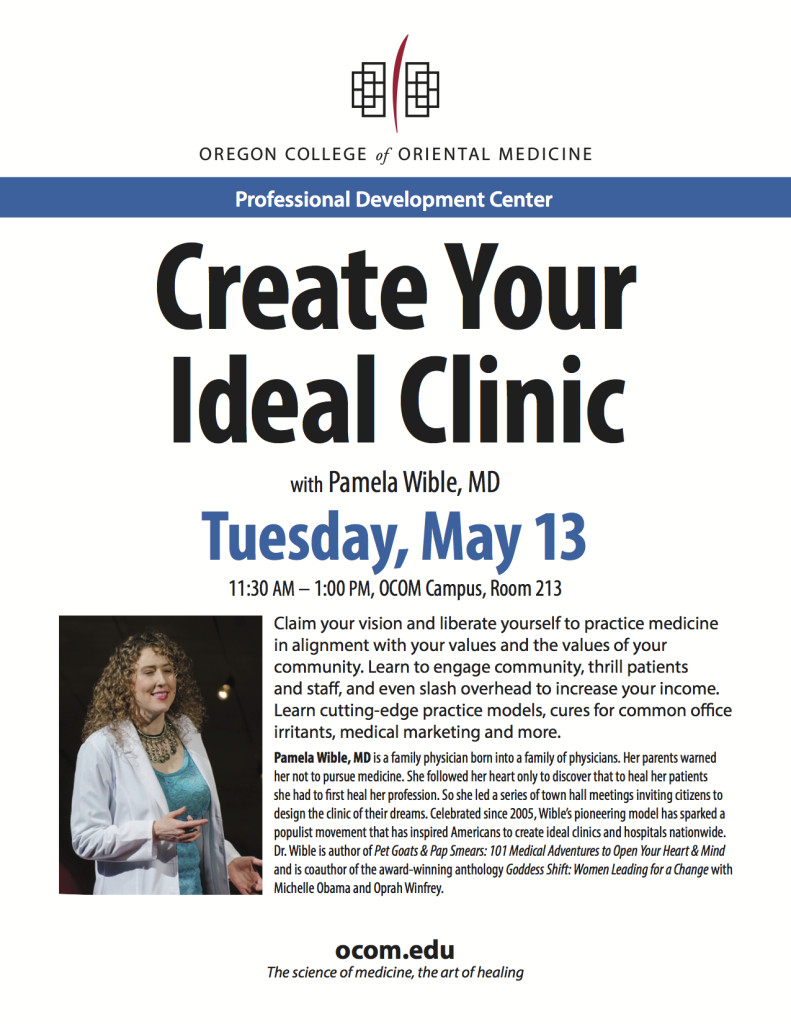
DR.WIBLE: To learn cutting edge practice models. Okay, here are some practice models:
1) Community-Designed Ideal Clinic: That’s like what I did. I put the patients in charge. Okay here are the 2 things: 1) You are either on relationship-driven health care or production-driven health care. 2) Then there’s another thing you have to decide: Are you gong to deliver patient-centric health care or physician centric health care? Basically the allopathic model delivers physician-centric health care in a production-driven model. Totally a slap in the face for the patient. Then they call it the “patient-centered medical home.” Total slap in the face. Now if you want to do a real patient-centered medical home, you ask the patient what they want. And none of them are asking, “Give me all the narcotics in the world.” They are not asking for unreasonable things. They want what makes them healthy, right? If you have a patient-centered practice that is relationship-driven, you will be super-happy. Because you won’t be having an invisible tug-of-war with the patient in the exam room which is how most doctors feel when they are trying to shove you on an algorithm and you aren’t even there for that. You are there to discuss your marriage. But we didn’t learn how to do marital counseling in medical school so it’s like a mismatch. You know? Whats going happen during that appointment? Give them Prozac? That isn’t even why they are there. It’s really muddy if you get out of balance with yourself and who you are and the further you get over here on the physician-centric production line the less in touch you’re gonna be with your patient, the less healed you are gonna feel from the visit, and it’s not gonna work out that well for your patient. So Community-Desgned Ideal Clinics I think is the coolest model ever because my town did that first and I love Eugene! 🙂
2) Ideal Medical Practice: There is also the Ideal Medical Practice model which is similar to what I’m doing but they didn’t do the town hall meeting part, but since patients and physicians mostly want the same things, it works out okay. Ideal Medical Practices tend to be more physician-centric because they didn’t do the town hall part.
Some people are actually clueless about what people in their town want because they never actually ask them. You don’t actually have to have a town hall meeting. Just carry around your cell phone or some sort of audio recorder and when you are in line or at the bus stop or the airport just start asking people near you, “Wow! I’m getting ready to graduate from medical school and I would like to know what would be like an ideal clinic for you? How would you want your doctor to treat you? Can you describe an ideal doctor?” People are bored out of their minds and they are waiting for buses, planes, their laundry to be finished, waiting in lines at grocery stores. Don’t waste a single minute. Start interviewing people wherever you are standing. And you will get amazing information without even having to have a town hall meeting. You just want to figure out what is the community zeitgeist. What is the spirit of the times? What do people feel right now in Portland, Oregon? What do they really want from a doctor? Who’s asking this? You might be the only one. Which is great. You’re gonna win. You’re gonna get all the patients. Because you’ll be doing what they want. Maybe you don’t want that many patients. Within 6 months I had to start a waiting list. And my waiting list was longer than my patient panel really quickly. It became so onerous to manage the waiting list that was longer than the number of patients I was taking care of that I had to stop keeping a waiting list.
3) Direct-Pay Model: This is basically the pre-1965, pre-Medicare model where people just did fee-for-service, like common sense. Pay some reasonable amount for some reasonable service from a doctor they liked in their neighborhood. Okay. That is coming back.
4) Concierge Care: This is for people who want to charge top dollar and roll out the red carpet for you. If you are one of those people you just have to see who do you want to serve. Maybe you want to serve rich Catholic people. So go to your church and tell them you are ready to start a VIP Catholic clinic. And people will come to you who are wealthy. You could do that and fly with them to Bermuda and do acupuncture on them while they’re are on the beach if that’s the kind of clinic you want to do. But maybe you are attracted to poor people so you can do the next really cool Benefactor Model.
5) Benefactor Model: The Benefactor model is where you attract rich people to share with the poor people like this guy did in Modesto, California. It’s also called the Robinhood Model. He went to his Catholic church and he said he wanted to open this clinic to serve migrant farmworkers. The only way to serve migrant farmworkers in the allopathic model is to get on the production line at a federally-funded community health center where you are pushing them through really fast. He wanted to do relationship-driven care with migrant farmworkers. But how are you gonna do that? Well, he decide to opt out of insurance altogether and charge $600 to $1500 a person per year for like an all-u-can-eat primary care buffet and for that amount of money they were adopting a migrant farmworker family. So it’s super-cool. You are not only paying for your own health care but also for a migrant farmworker. That is local charity that works. Instead of sending money to a charity far away where 94% goes to administration. A local doctor you trust is actually doing this. I would take it a step further and introduce them to the person they are supporting and make sure they spend Christmas together and become best friends. (laugher) I think people need to break out of their social circles and hang out with people who are really different from them and have a mind expanding experience. And it is great because you are supporting someone locally. And you are the cool person who is manifesting all of this! Without you it would never happen.
6) Membership Medicine: Kind of like a gym membership. You pay to join the club and then a monthly fee and it’s reasonable. It’s kind of like concierge care for the masses.
7) House Call Practice: Do house calls for elderly people or people who are busy or even do visits on people at work. Maybe they are workaholics and they want their acupuncture during their lunch break laying on their desk.
8) Low-Overhead Model: There’s the low overhead model which I think you should do no matter what. Unless you are trying to do the VIP thing where you have the biggest statue and best fountain in town and everyone comes to you so they can brag that they are in brand-name doctorville. Otherwise I think you should do low overhead because you will be economically free from the noose that would be otherwise around your neck.
9) Solo-Solo Model: No staff. You do everything like what I’m doing.
PART THREE (video):
10) Free Clinic: This is the Patch-Adams-style clinic. He basically worked outside jobs and the doctors each contributed $250 per month for a 6-bedroom house that they called a clinic. Patch Adams never charged anyone a dollar in his life as a physician. He just worked outside jobs for the joy of giving away health care for free. That’s totally available to you too if that feels good.
11) Dual-Business Model: This model is super-cool but not enough people have done this. You would be so newsworthy and get free publicity from this like your whole life. Do a dual business model. Do 2 different businesses at once or somehow work with another business. Say you want to attract an intellectual crowd then open your clinic in Powell’s [bookstore]. Your whole waiting room could be like a bookstore. Or you could work in a gym or like this real story of a lawyer in L.A. who opened a hot dog stand. Every time his hot dog stand opened he had a line that went around 3 whole city blocks because he gave out free legal advice with every hot dog (laughter). And there’s a guy in Chicago where the malpractice rates are so high that he wanted to open a coffee shop and give free physicals in the back room, but make all his money from the coffee. There’s a woman Chrissie Ott in town and she uses the coffee shop next door as her waiting room if she runs late. Kind of like my soap basket thing. On rare occasions when she’s late, patients can go to this Java Stop place or whatever next to her and get a free cup of coffee because she worked it out with the owner at that place and they are gonna support each other. Wouldn’t that be cool?
Cures for common office irritants. I do not do any refills between appointments because it is just a pain in the butt. Nearly 30% of all phone calls to medical clinics are for refills. Figure out how much your patient can handle. Like your diabetes is in good control so I’m gonna give you a 3-month supply or a 6-month supply. Or you’ve been on the same thyroid dose for 2 years so I’m gonna give you a year’s supply. If you only give them a month-supply they are gonna be calling and begging like an annoying child who wants the cereal you don’t want to buy them. Like you’re gonna feel like people are nagging you all the time. But it’s your own fault. We create our own dependent monsters as patients depending on how functional we are and how willing we are to be adults.
In allopathic medicine we are told to treat everyone like a fourth grader. Speak to people on a fourth-grade level because ether are stupid and they won’t understand anything and so if you do that you are dumbing your patients down possibly. And you are creating them into dependents and you develop an adversarial relationship with them So I recommend that you be a functional adult and treat your patients as if they are able to be high-functioning adults. Raise the bar on their behavior and they will meet you there. It’s like puppy training. Want a really good puppy? Be consistent. You’ll get respect and a mutual relationship that works.
I have a no-show and cancellation fee which I think everyone should have otherwise people will devalue your service because if they can just not show up over and over again and there is no penalty then that’s what you will attract. So I charge $50 for no shows and cancels < 24 hours notice.
QUESTION: How do you take care of uninsured and insured patients and charge appropriately. How do you take insurance at the same time. It’s like no man’s land. Everyone’s like afraid, but nobody will give real answers. So as physicians how do you figure it out?
DR. WIBLE: If you are going to take insurance you can not have 2 separate fee schedules. You can’t charge uninsured one way and insured another way because that is considered insurance fraud. You have to have one fee schedule and then you maybe can have 30% off (which is what I give) for Payment At Time Of Service (PATOS). So there’s lots of information out there about whether you should to should not take insurance. I have some of that in the FAQ and a lot in my teleclass that I teach. A lot of this is actually illegal to talk about because you can’t really sit with another doctor and say, “Hey what do you charge for a 99214?” If you have that conversation that is also considered insurance fraud because those 2 doctors could take down the entire insurance industry, right? You know, that’s ridiculous. They basically intimidate people into paralysis. I think we need to step up and stand up. If you want to figure out how something is done, go find someone else in your field who’s already in solo practice in town. Take them out to lunch and pick their brain. People are more than happy to help one another open clinics, but most people just sit by themselves and wonder, “Oh, how will I do it?” Ask around. And have lots of mentors.
Phone calls, by the way, I’m still answering what do I do to get rid of all the staff. Emergency phone calls go to my cell phone. Non-urgent phone calls go to my landline so 99% of all my calls are waiting for me on my landline which I have at home because it is so much more convenient for me to answer questions before and after dinner and after I do the laundry or whenever I feel like it. I don’t do cyberspace or phone medicine. People are mostly calling for appointment or calling for clarification on something they may not have understood. Most of that is really via the computer. Like I really don’t use the phone that much. Everything is simple questions. When was my appointment? What was the Vitamin D dose? But I rarely get disturbed at all. Now during appointments I am sending e-mails to the patients that summarizes the top 3 things we discussed so by the time they get home they have the e-mail from me that reads: 1) Call this energy worker 2) Try reiki 3) Take Vitamin D at this dose, etc. Patients do not need their entire chart note. They need the 4 or 5 essential sentences with links and phone numbers for what they need to do. By the time their visit is over they have their notes.
Medical marketing: Do not ever, ever, ever spend any money on advertising. It is ALL word of mouth. Like you make one person happy and they will tell the whole town. One day, I got 5 people calling from the same employer for appointments. I was like, “Why are you all calling?” They said so-and-so went to the cafeteria and stood up on a chair and said, “Oh my God! You have to call Dr. Wible. She’s Amazing!” And she read my phone number to everyone and 5 people called. One happy patient can fill your entire schedule. So since you start your practice kind of slow, you can just VIP people out the first month or two. People will be so happy they will call their relatives out of state to share what happened. They will tell all their friends. In Eugene, I always see physician ads on the side of buses and that’s kind of dumb. People don’t pick their doctors based on pictures on the bus. People pick their doctors who will be sticking fingers and stuff up inside of you on recommendations from friends and family. You know what I mean? You’re not just gonna go to a gynecologist because you saw his picture on a bus (laughter). You’re gonna ask your friend or your sister if you have a problem. You’r not gonna pick someone you saw on a bus. That’s just common sense.
Need advertising? Call the newspaper up and tell them you are giving soap to your patients. Or you started a free something or a hot dog stand with acupuncture and hot dogs. Think of a combination that is funny and something that rhymes. Herbal hot dogs? Free! On this corner a mob something with hot dogs and herbs. Get excited! Bring balloons and bring this guy [skeleton] and stand on the corner.
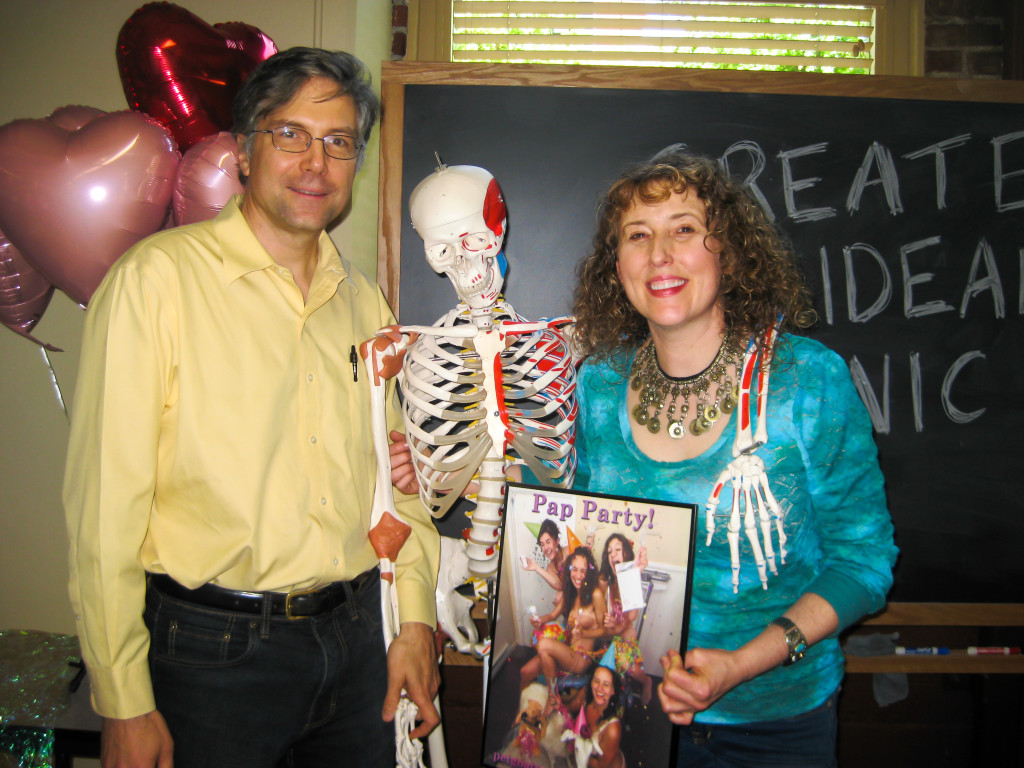
With the news you have to make it visual. Balloons, skeleton, make it interesting looking. If you are only doing things with small needles they can’t see, it’s not as dramatic of a photo or video shoot. You can get a whole article written about you on a full-page of the Oregonian which is so much better than you promoting yourself and paying for advertising. And finally I will say MEDIA BEGETS MEDIA. The more media you get, you just keep recycling it. Pretty soon you will be in Boomers & Seniors News, your church newsletter, the Oregonian. It just keeps going like that.
Okay. Quickly, I’m going to answer some questions that were sent to me by your group on Facebook:
QUESTION: Andy Vile asks, “I, personally, tend to get a lot of very seriously ill, even terminal, patients… Any ideas about how to cope with the psychological/emotional toll on us as practitioners would be great. I have a little support group of other practitioners that talk to each other to help process the emotions surrounding this… but, any other ideas would be great.”
DR. WIBLE: Okay. Death is not failure. Illness is not failure. You’ve got to get into the spiritual zone. Some people want to die young. Longevity was not their life plan. They need to do certain things and pass on to do something else. I don’t know if you believe in reincarnation, but it really helps to have a bigger perspective on life that what you are doing right now. Reframe their illness as an amazing spiritual journey. Every time I give somebody bad news I always switch it around, “Wow! This is going to be a great opportunity to break free of this habit, do this . . . recently I diagnoses someone with breast cancer and you really need to ground them in something other than physical bad news.
Physical bad news is just kind of a downer (and inevitable). I would recommend that you read death section of my book. Basically the book has 8 different sections and they are things that we didn’t learn in medical school that we need to know to be a good doctor like joy, creativity, love, how to handle death. It’s amazing we don’t learn this in med school. And intuition. In the death section of my book you can see that you can be playful about death. It doesn’t have to be a downer, ya know. It’s actually my favorite thing to do with patients: to die with them (laughter). My favorite thing to do is to be there as they transition because that is really beautiful and I so much prefer that to birth. babies don’t really tell you anything. They just cry. But there are words of wisdom that patients reveal at the end of their lives that are profound. Be there to listen to that last sentence.
I also think professional closeness will help. The whole idea that I’m going be stoic and stand over here and you are going stand over there. That doesn’t really help with the feeling that we are in this together. Being in it together and feeling the excitement of the unknown together is kind of cool.
Weekly therapy for anyone in health care who sees trauma, death, loss. We should just be going to a therapist which I think should just be part of our training program. Even if you have to pay for it yourselves. I’ve been going weekly for 5 years to a medical intuitive to help me with a lot of things I am trying to understand such as physician suicide and other topics that are not that easy to understand. Things that are other-worldly. Going and getting a massage once a week. Having some sort of release at the end of the day—a shower or swimming—something where you get it out of your system. And a baling group which many doctors may have had during training. I did. Where we all got together 4 or 5 of us and discussed cases and how they made us feel. So it wasn’t really a case report to discover something new about a disease it was more like, “when I’m with a patient with this here’s how it makes me feel.” People hear each others feelings and get to process how they feel. Start a baling group because we need each other to heal.
QUESTION: How do you maintain boundaries? What do you consider the most important boundaries to maintain?
DR. WIBLE: Well you have to know your own boundaries and then make them clear to the patient. Patients want to be good puppies. But you have to say what the rules are. Often we don’t do that and then we get frustrated because they broke the rules that we never explained or we’re not consistent with. It’s really important not to accept abuse. Abusive contracts abusive employers, abusive patients. It’s just gonna go downhill from there. Nothing gets better. You are basically saying, “Shit on me.” You know what I mean? You may have to fire people. You may have to say this is no longer a therapeutic relationship. If you are sitting up at night thinking of a patient over and over again who is really getting on your nerves, you may need to fire them as it may not be working out because you are spending so much of your personal time obsessing. Maybe they need a different kind of doctor. It’s too much of a struggle.
QUESTION: How do you handle insurance billing as a solo doc?
DR. WIBLE: I use OfficeAlly, but there’s lots of free online clearinghouses. Free. And it’s easy. I do it right after the appointment.
QUESTION: Do you offer sliding scale?
DR. WIBLE: No. Because you can not do that legally and have insurance contracts. I offer 30% for Payment At Time Of Service (PATOS). Or I can NOT take insurance and do whatever I want—charge 10 dollars per minute. Whatever you decide.
QUESTION: Do you do pro-brono work?
DR. WIBLE: No. I don’t believe in giving anything away for free. I believe if I’m going to offer them something then they need to pay it forward. This rarely happens, but if someone is gonna see me and they don’t have any money then they need to donate to the gift basket so somebody else can have their handmade cards or lotions or potions. Or they need to volunteer at the soup kitchen. They need to do something. This isn’t about being passive, help me, help me without contributing anything to someone else. That’s not health care. I don’t recommend giving yourself away for free.
QUESTION: Any real-world practical thoughts you may have about practice management and care for your patients will be awesome.
DR. WIBLE: 1) Do what you love and people will love you. 2) Have fun and patients will have fun. 3) Never pay for advertising. 4) Do today’s work today (like don’t leave your office with a pile of stuff unfinished).
QUESTION: Share mistakes or pitfalls when establishing a practice.
DR. WIBLE: I’ve interviewed tons of doctors on this and it’s in my workbook that I use in my physicians retreats. Here are the top ten. 1) Not adhering to your original vision (and community vision). 2) Not making your mission clear to patients. 3) Don’t rent too much space—expensive. 4) High overhead. 5) Hiring experts—practice consultants and gurus. 6) Ignorance, fear, self-doubt. (watch video for great plumber and electrician story not transcribed here) 7) Listening to naysayers, negative feedback from doctor friends. 8) Hiring staff. 9) Buying expensive technology. 10) Not having mentors. (more detail provided on the video)
QUESTION: How best to approach MDs for integrating acupuncture or herbal therapies with their patients.
DR. WIBLE: Please understand that a lot of MDs are on the verge of suicide (depression, burn out) so the best thing to do is to say, “Hey, do you want to come for a free treatment after work? I really want to show you what I do. Look, I just graduated from school and I have all the energy in the world and I think I can help you. Then they will have real word experience with you and what you offer and they can tell their patients from first-hand experience. “Oh, you got to go see Jennifer. I go to her. She does acupuncture on me every Friday.” they need to know what you do and experience what you do so they can explain it. So I really recommend that you go find the most miserable doctors and offer them help. Who else is going to help them? We have to help each other heal if we are really healers. Then you’d have referrals for the rest of your life from somebody who may literally tell you, “You saved my life.” Wouldn’t that be cool? Instead of having an adversarial relationship with allopathic doctors.
And also doctors are so busy and there are certain cases they just don’t like. Complex cases in 12 minutes is a huge irritant. So go to a doctors office and tell them how much you love complex cases that they hate. Tell them you love patients with high needs psych issues. Oh my God! You would be like an angel. You could literally save their practice. Offer something that they need personally or that they need help with in regard to their patients.
QUESTION: From your perspective, what is the best way for Chinese Medical practitioners to interface with MD’s regarding patient care?
DR. WIBLE: 1) Work in same office or close by in a “wellness center.” 2) Integrate the treatments in one office visit as I mentioned previously. Do acupuncture and psych visits together.
QUESTION: What are your top 3 best practice tips, etc.
DR. WIBLE: 1) LOVE people. 2) Have FUN. 3) Work part time.
QUESTION: What was the tipping point for her to change paradigms?
DR. WIBLE: 1) Misery. 2) Suicidal thoughts. 3) Dreaming of waitressing again. (more details on video)
QUESTION: What would you tell a new practitioner regarding patient care and practice management?
DR. WIBLE: 1) Solo practice is easy. 2) Plumbers and electricians do it. 3) All you need to know is far easier than understanding the Krebs cycle.
QUESTION: How do you fit in insurance billing?
DR. WIBLE: It only takes 1 to 2 minutes after each patient. It’s super-easy. Most of these online electronic clearinghouses are free and they store your data. The first visit you need to enter the demographics (name, address, phone number) and then it is all stored in their system. So all you do is go back in there and pull up the name. Change the date. You probably have memorized the top codes for your services, the most relevant diagnosis codes like 789.00 abdominal pain, 729.5 pain in a limb. You just put that down and press update and you get paid 2 weeks later by the insurance company. And this is a really high reimbursement zone so this is actually a great place to take insurance if you want to make good money. If you work in the middle of Ohio you can do the same thing and get paid 1/3 as much. I have no idea why there are wildly divergent reimbursement rates around the country, But I can assure you doctors and patients are not happy in central Ohio. If you want to get paid a lot move to Alaska. They have the highest reimbursement in the country. These are all things that you would know from just asking around and meeting other acupuncturists from Alaska. Maybe you should start an online group of acupuncturists—alums from here—and compare notes. Create your own network of supportive people who you can ask questions to in the middle of the night.
QUESTION: Did you hire a billing company or farm some of the insurance work out?
DR. WIBLE: I do everything myself. I’m a control freak. And I find this stuff really interesting. In order to find out what is dysfunctional about health care, I wanted to have the whole rubik’s cube in my hand. Then I’m like, “Wow, this is interesting. This is what they’re saying on the phone an that doesn’t make any sense.” Otherwise, everything happens in cubicles and as a business owner you really need to understand what is happening in all the cubicles. And as somebody who wants to speak intelligently about health care policy and the direction of health care in the country, you should understand who’s doing what in what cubicle. And you might have something intelligent to say that would help other people avoid misery-provoking models and systems.
QUESTION: Since you are probably more aware of how much things are for patients, do you find yourself making decisions based on that price tag for patients?
DR. WIBLE: No. But I do know that if you put mental health diagnoses first, claims can get denied. So even though somebody comes in with depression, I always ask, “Well how does that feel for you there? Are you getting a headache?” (laughter) So I code the physical symptoms first (headache, stomach pain) and put the mental health diagnosis at the end because if you put depression first the insurance company may not cover the bill. TMJ is also not covered. Dental and mental codes are often not covered. I guess they think we are bodies without heads and teeth.
QUESTION: In my community people keep asking the same sorts of questions. What do you think of offering community education or classes?
DR. WIBLE: I have to repeat the same sinusitis discussion over and over again and no, I don’t have group sinusitis classes but I could. If that makes sense to do, you could offer it. Especially for patients who need support making lifestyle changes with diabetes or high blood pressure, Or is you had the energy (obviously my energy is going into healing the entire health care system an so I’m not doing fun groups with my patients), people are totally receptive to groups so you just have to see who would want to do it. And if you could bill for it.
QUESTION: Are there things that you have learned through doing that LOVE model that if you would have known during the SHOVE model would have changed your experience?
DR. WIBLE: Why was I so weak? Why didn’t I get this? I don’t really understand why people have to suffer so much before ether get it. You low what I mean? I’m somebody who apparently needs to suffer more than the average amount. Thats why I’m here. I don’t want you all to suffer the way I did. It seems so unnecessary. I wish I would not have taken the abuse as long as I did.
QUESTION: is there a online community where doctors are discussing this?
DR. WIBLE: There are pockets where docs are discussing these topics. A lot of these discussions are physician-centric and they are not really making their case to the patients. Really I think this is going to be led by patient demand because so many doctors are zoned out. No matter how many times you give them a free Pet Goats & Pap Smears and say, “You can do it!” They need so much therapy to recuperate from the trauma that they’ve seen and sustained. That’s why I offer physician retreats at Breitenbush for 3 and a half days. I just got back from one last week where I provided 8 years of my best practice management plus we did exorcisms on like 20 people with PTSD which is why I needed to take a nap for 2 days when I got back because that was exhausting. This has to be led by patients. Patients have to boycott clinics that are disrespectful and seek out doctors who respect them, doctors who are actually provided healing. The more people who get brave enough to move to that model, the faster it will happen. This [ideal medical care] is going to happen. It’s just a matter of velocity. How fast do we want people to have ideal medical care in this country? Or do we just want to piddle along the way we are and be miserable and have more doctors die every day of suicide. How much trauma are we willing to take as a culture? How much misery do you need to feel in your body before you are willing to stand up for yourself and everyone around you? It’s a ripple effect.
Here’s a weird aside. I never had kids and when I speak to medical students sometimes I feel like I’m breastfeeding (laughter). It’s a maternal thing for me. I really want to help all these baby birds jump out of the nest and freely fly through the sky and do their own thing. So it’s the nipple effect, like the ripple effect (laughter). All you have to do is be loving and love your life and get out there and people will see that you are happy and they want to be happy too so they want to see what you are doing that’s right. And how can they suckle a little bit and learn from you.
So really we need more heart and soul and we need more people willing to open their hearts and souls and be free so we can show other people the way. We are a beacon of light. Every one of us.
QUESTIONS: Do you do appointment reminders of follow-up calls after visits?
DR. WIBLE: No. People get their appointments the same day so there is no time to remind them. They just called and now they’re here. It really works if you don’t have a backlog If you get a good panel size and have a nice flow you can see everyone without much of a delay (same day, next day). Ya know, 80% of people’s ailments will go away on their own in 2-4 weeks. If you make them wait, their pain may go away and they’ll forget their appointment. Really what’s happening during their appointment is like what Patch Adams says, “Well, I tricked them to come in with their knee pain, but really were doing a lot of other stuff, helping them get rid of loneliness and despair, working on their marriage . . ” There’s a lot of healing that happens that we can’t even put words to. People are just out of balance and not connecting so sometimes sitting with you uninterrupted for 30 t0 60 minutes could be the only time anyone is really listening to them all week, where they feel heard. And the value of that you can’t put into words.
And, by the way, you should not feel that you are imposing on people when you ask their opinions. Some shy people and people who may feel nervous going up to someone at the laudromat or bus stop and ask, “What would an ideal visit be?” Before I used this cover on my book, I interviewed people in airports and shopping malls. I asked, “Hey if you saw a book cove like this would you get it? Or “What do you think this is about?” I just did a survey. I was at Market of Choice in Eugene near closing time. I asked this woman and she started crying. She answered the questions and then told me, “This is the best thing that ever happened to me.” I said, “Ever?” In your whole life?” and she replied, “Yes. That somebody would come up to me and ask my opinion on a book cover.”
People are starving for human contact and to be asked their opinion on anything. This other guy I asked at a parking meter in downtown Eugene said, “You know more people should walk around town asking people what they think about things. Even if they’re not running for political office. Just because they give a shit.” That’s how hungry people are for you to ask them what they want. Any topic. Anything. People are disconnected. They need to have conversations about anything with anyone who’s real. Uplifting conversations. So go get your tape recorder.
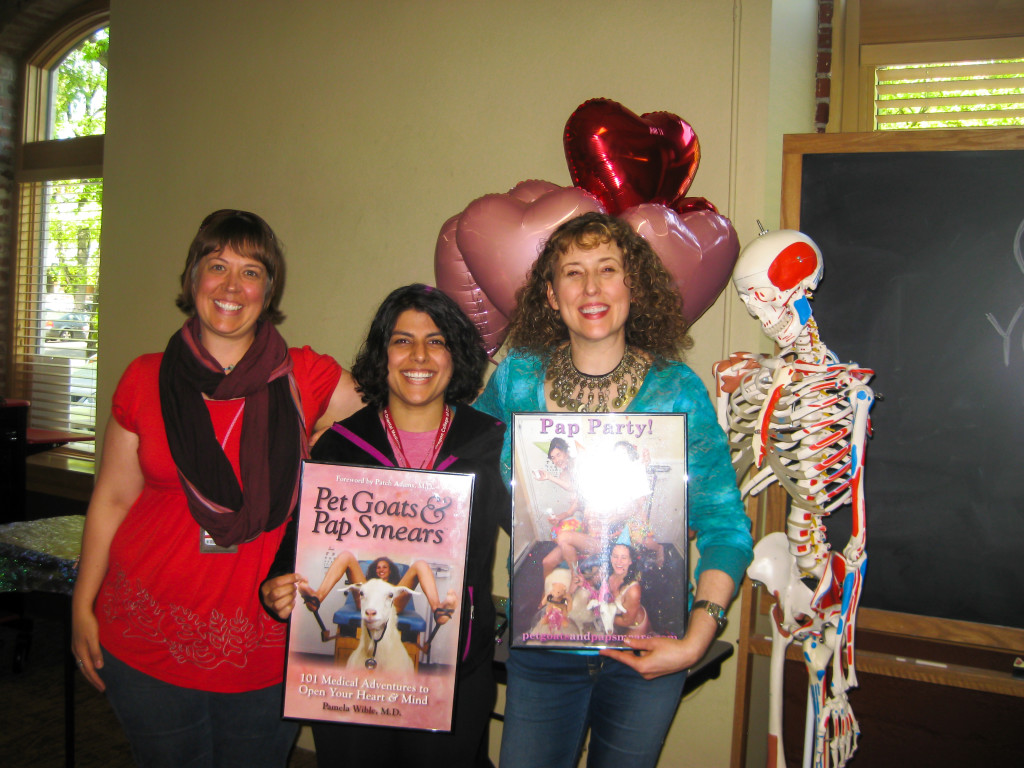
QUESTION: What breed of goat do you have?
DR. WIBLE: It’s not my goat. I forgot what breed she is. But her name is Charity. And all the proceeds of the book go to charity, meaning helping doctors break free and open ideal clinics. It’s kinda weird how I ended up with a goat in there. It’s a long story.
MAN IN AUDIENCE: I just think everybody here is lucky to have you come and tell the truth like you did.
DR. WIBLE: Okay. Well, pass it forward. Spread the news. Oh, that’s another thing you can do. If you don’t want to record people, you can go door to door and introduce yourself with your family and a little red wagon. You don’t have to be a Jehovah’s Witness. You can be the other kind of proselytizer and say, “Hi, I’m here with an organic apple and I’m opening a clinic right around the corner and I just want to know what hours would be convenient for you. . .”
Listen to the video/audio to hear my fun chiropractor story at the end.
I hope you enjoyed this and read the entire transcription. OMG! Took me forever to type this out so I do hope it is helpful for you.
XOX
🙂 Pamela
Pamela Wible, M.D. is a family doctor is Oregon. Watch her TEDx talk on ideal medical care. Special thanks to the man in the audience, Jeffrey Goodman, who filmed this event.



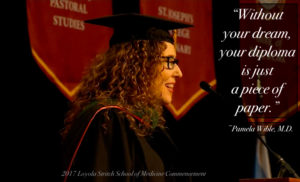
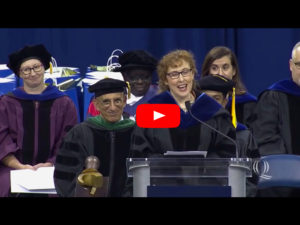
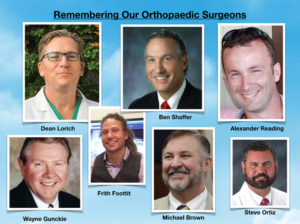
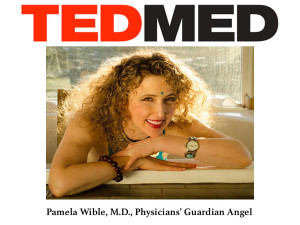
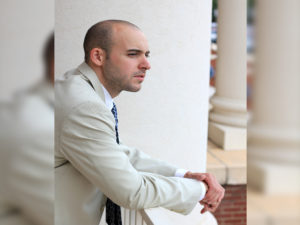

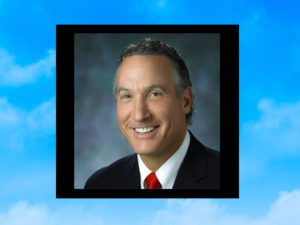

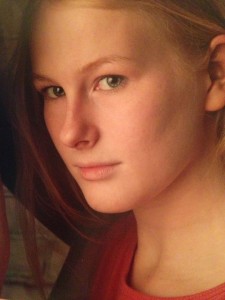
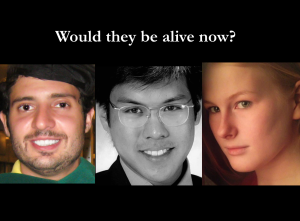
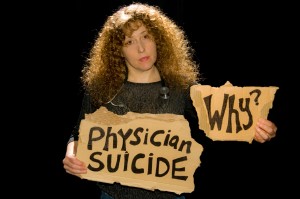
I just read (almost) this entire post, and I’m extremely grateful for the transcription 🙂 I want to say thank you again Dr.Wible, you are so inspiring it makes me excited for my future. I have this page bookmarked because I thought how you explained death and how physicians should approach death, or just how people should approach death in general was beautiful. I love your advice and I always come back to it. Thank you. 🙂
You are very welcome to steal and incorporate any of my ideas. Please share with others. There is so much despair in the medical profession. We need to actively help each other heal.